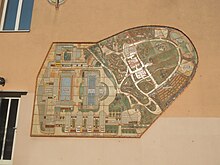Laaerbergbad
The Laaerbergbad is an urban summer pool on the Laaer Berg in Vienna's 10th district of Favoriten . The Gradner Chapel is next to the bath .
history
The Laaerbergbad was built between 1957 and the opening on August 14, 1959 according to plans by Erich Franz Leischner on a plot of around 6 hectares on the southern slope of the Laaer Berg. In order to preserve the trees, mostly pines , growing on the construction site , around 100 of them - up to 25 years old and 6 meters high - were moved to new locations by January 1958.
Numerous Austrian artists were involved in the artistic design of the bath. There is a mushroom-shaped game table with a compass rose mosaic ( Ladislaus Stecker ), a statue of a discus thrower ( Rudolf Beran ) and two artificial stone turtles at one of the children's playgrounds ( Othmar Jarmer ). The artistic equipment also includes two ceramic orientation plans by Leopold Schmid on the walls of the entrance building. Also by Josef Mikl , Karl Kreutz Berger , Heinz air , Anton Krejcar , Ferdinand Kitt originate mosaics . In 1994 the restoration of the mosaics from the time of construction, carried out together with renovation work on the facades, was completed. Where it was not possible to obtain the originals, the mosaics were faithfully remade with the support of the Federal Monuments Office and the Department of Culture of the City of Vienna .
The 50 meter long and 15 meter wide sports pool with a maximum depth of 5.1 meters was renovated in 1989, as was the 65 meter long wave pool in 1985 . This year, a 40-meter-long water slide (which has since been dismantled for reasons of age) and a water mushroom and an elephant slide - a slide that resembles an elephant in profile - have been installed as new attractions .
When planning the Laaerberg pool, the possibility of holding sports competitions was also taken into account and the sports pool was dimensioned accordingly, lockable from the rest of the pool and provided with seating and standing space for around 1,350 spectators.
In 1998, with 170,000 visitors, the Laaerbergbad was the most frequently visited urban summer pool after the Gänsehäufelbad and the Schafbergbad . Most recently, 123,503 (2004), 119,822 (2005) and in 2006 151,850 people visited the summer pool.
Two people were killed in accidents at work during the construction of the Laaerbergbad.
description
On the property near the Favoriten district and the Franz Horr Stadium , four one-story halls with 4,180 boxes and a cabin building with 440 changing rooms were built in addition to the swimming pools. Emergency cloakrooms in intermediate structures offered additional space for several hundred people. The flat roof of the cabin building was set up as a sunbath - separated by gender.
In addition to the sports and wave pools already mentioned, the Laaerbergbad has, among other things, two children's pools, water games, a parent-child area with a toddler pool, water preheated using solar panels (installed in 1991 and expanded several times), a diving tower, a play and sports field and one Beach volleyball court, table tennis, sunbathing and a shower system at the beach volleyball court.
The landmark of the Laaerbergbad was the approximately 20 meter high water tower at the north-western end of the area. Outwardly, it functioned as a clock tower; in fact, around 100,000 liters of water for the three swimming pools and the filter system were stored and preheated here. Due to its poor structural condition and high renovation costs, it was demolished on October 19, 1998.
The Laaerbergbad has a water treatment system to free the pool water from chlorine and organic substances and then use it to irrigate the green areas.
reachability
- Ludwig-von-Höhnel-Gasse 2, a small parking area for cars and bicycles
- Altes Landgut : underground line U1 ; Bus route 15A
- Neulandschule Laaerberg : Bus 15A, access to the Generali-Arena
See also
Web links
- Laaerbergbad (MA 44 - baths)
- The new summer pool on the Laaer Berg . In: Official Gazette of the City of Vienna , No. 35/1957 (LXII. Year), May 1, 1957. City of Vienna - Press and Information Service, Vienna 1957, ZDB -ID 562440-X , p. 3 f and 8 f. - Full text online .
- A bathing paradise for the Viennese in the south . In: Arbeiter-Zeitung . Vienna August 28, 1957, p. 5 ( Arbeiter-zeitung.at - the open online archive - digitized).
- The bathing paradise in the south is ready . In: Arbeiter-Zeitung . Vienna August 15, 1959, p. 7 ( berufer-zeitung.at - the open online archive - digitized).
literature
- Claudia Feichtenberger: Our baths - from the bathing room to the adventure world - Viennese bathing culture then and now , Compress Verlag, Vienna, 1994, ISBN 3-900607-257
Footnotes
- ↑ http://www.wien.gv.at/vtx/vtx-rk-xlink?SEITE=%2F1999%2F0717%2F002.html
- ↑ Vienna City Hall correspondence of January 23, 1958, sheet 107
- ^ Laaerbergbad in the Vienna History Wiki of the City of Vienna
- ↑ http://www.wien.gv.at/vtx/vtx-rk-xlink?SEITE=%2F1994%2F0930%2F018.html
- ↑ Laaerbergbad - summer pool of the city of Vienna on wien.gv.at, accessed on February 10, 2017
- ↑ written information from MA 44
- ↑ Vienna City Hall Correspondence of July 11, 1985, sheet 1707
- ↑ Vienna City Hall correspondence of August 14, 1959, sheet 1644
- ↑ http://www.wien.gv.at/vtx/vtx-rk-xlink?SEITE=%2F1999%2F0717%2F002.html
- ↑ http://www.stadtrechnungshof.wien.at/berichte/2007/lang/2-08-KA-III-44-1-7.pdf
- ↑ Vienna City Hall correspondence of August 14, 1959, sheet 1642
- ↑ Vienna City Hall correspondence of August 27, 1957, sheet 1726
- ↑ Thermal solar systems in Vienna's urban baths ( Memento from November 15, 2004 in the Internet Archive )
- ^ Vienna City Hall correspondence of October 9, 1958, sheet 2028
- ↑ written information from MA 44
- ↑ http://www.wien.gv.at/vtx/vtx-rk-xlink?SEITE=%2F2008%2F0513%2F020.html
Coordinates: 48 ° 9 '32 " N , 16 ° 23' 4.7" E



